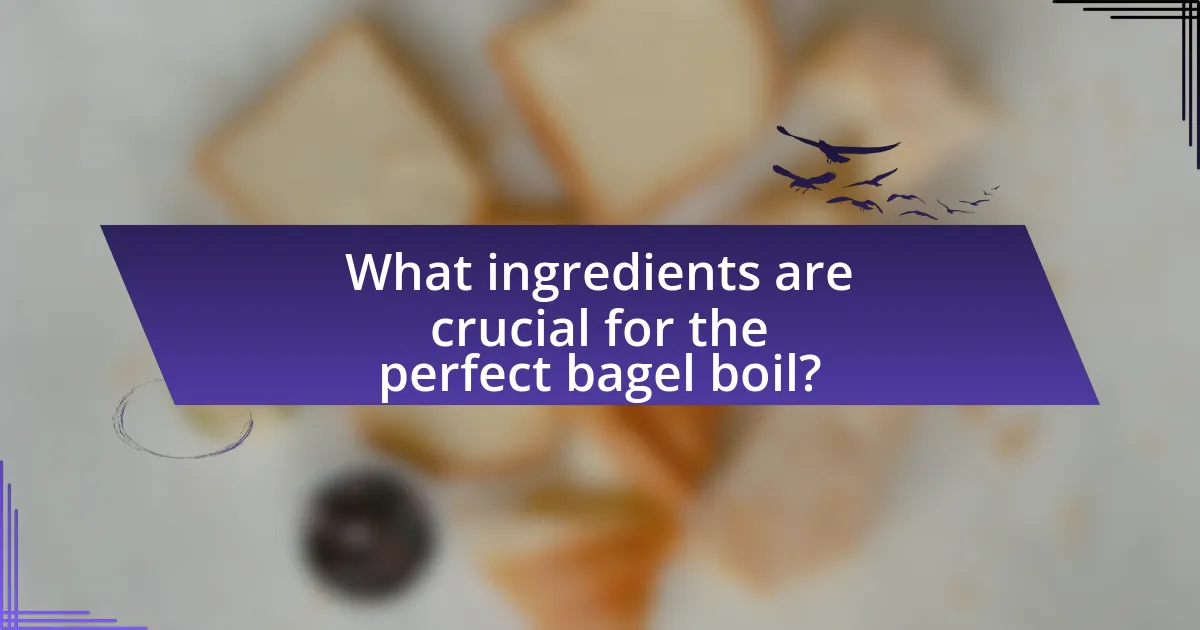The article delves into the science behind the perfect bagel boil, emphasizing the role of alkaline water, typically enhanced with baking soda or lye, in achieving the bagel’s unique texture and flavor. It explains how boiling affects the bagel’s crust and density, highlighting the importance of temperature, boiling time, and the chemical reactions that occur during the process. Key ingredients such as malt syrup and baking soda are discussed for their contributions to flavor and texture, while best practices for boiling are outlined to ensure consistent results. The article also addresses common mistakes to avoid and the impact of water quality on the final product.

What is the Science Behind the Perfect Bagel Boil?
The science behind the perfect bagel boil involves the use of alkaline water, typically enhanced with baking soda or lye, which contributes to the bagel’s distinctive texture and flavor. This alkaline environment gelatinizes the starches on the surface of the bagel, creating a chewy crust while allowing the interior to remain soft. The boiling process also helps to set the shape of the bagel, preventing it from expanding too much during baking. Research indicates that a higher pH level in the boiling water results in a darker, shinier crust due to the Maillard reaction, which occurs more readily in alkaline conditions.
How does boiling affect the texture of bagels?
Boiling bagels significantly enhances their texture by creating a chewy crust and a dense interior. The boiling process gelatinizes the starches on the surface of the dough, which leads to a firmer outer layer once baked. This technique also helps to set the shape of the bagel, preventing it from expanding too much in the oven. Additionally, the boiling water can contain additives like malt or baking soda, which further contribute to the bagel’s flavor and color. Studies have shown that bagels boiled for a longer duration develop a thicker crust, which is a characteristic feature of traditional bagels.
What role does temperature play in the boiling process?
Temperature is crucial in the boiling process as it determines the phase change of a liquid into vapor. When a liquid reaches its boiling point, which is the temperature at which its vapor pressure equals atmospheric pressure, bubbles form and the liquid transitions to gas. For example, water boils at 100 degrees Celsius at sea level; this temperature allows the molecules to gain enough energy to overcome intermolecular forces. Thus, maintaining the correct temperature is essential for achieving the desired boiling effect, particularly in culinary applications like bagel preparation, where the boiling temperature influences texture and flavor.
How does boiling time influence bagel density?
Boiling time significantly influences bagel density, as longer boiling times result in denser bagels. When bagels are boiled, the starches on their surface gelatinize, creating a barrier that affects moisture retention during baking. A longer boil allows for more starch gelatinization, leading to a firmer and denser texture. Research indicates that boiling bagels for 30 seconds to 2 minutes enhances their density, with optimal results typically achieved around 1 minute. This process also contributes to the characteristic chewy crust of bagels, further reinforcing the relationship between boiling time and density.
Why is the boiling process essential for bagel making?
The boiling process is essential for bagel making because it creates the bagel’s characteristic chewy texture and shiny crust. When bagels are boiled before baking, the high temperature gelatinizes the starches on the surface, which helps to form a barrier that retains moisture during baking. This results in a denser interior and a glossy exterior. Additionally, boiling in water with added malt or baking soda can enhance flavor and color, further contributing to the bagel’s unique qualities.
What chemical reactions occur during the boil?
During the boil of bagels, a Maillard reaction occurs, which is a complex chemical reaction between amino acids and reducing sugars that gives browned foods their distinctive flavor and color. This reaction is crucial for developing the bagel’s characteristic crust and enhancing its flavor profile. Additionally, the boiling process gelatinizes the starches on the surface of the bagel, creating a barrier that helps retain moisture during baking. The presence of alkaline substances, such as baking soda or lye, in the boiling water further contributes to the browning effect and texture by raising the pH, which accelerates the Maillard reaction.
How does boiling contribute to the bagel’s crust formation?
Boiling contributes to the bagel’s crust formation by gelatinizing the starches on the surface, which creates a chewy and glossy exterior. This process occurs when the bagels are submerged in boiling water, typically with added ingredients like baking soda or malt, which enhance the Maillard reaction during baking. The high temperature of the boiling water causes the outer layer of the dough to set quickly, forming a barrier that retains moisture inside while allowing the crust to develop a distinct texture and color during the subsequent baking process. This method is essential for achieving the characteristic bagel crust that is both firm and flavorful.

What ingredients are crucial for the perfect bagel boil?
The crucial ingredients for the perfect bagel boil are water, malt syrup, and baking soda. Water serves as the primary medium for boiling, while malt syrup contributes to the bagel’s flavor and color, enhancing the Maillard reaction during baking. Baking soda increases the alkalinity of the water, which helps achieve the characteristic chewy texture of bagels. These ingredients work together to create the ideal environment for boiling, resulting in a bagel with the desired crust and chewiness.
How does water quality impact the boiling process?
Water quality significantly impacts the boiling process by influencing the boiling point and the overall effectiveness of heat transfer. High mineral content, such as calcium and magnesium, can raise the boiling point of water, making it less efficient for cooking. Additionally, impurities and contaminants can alter the water’s properties, affecting how heat is absorbed and transferred during boiling. For instance, water with high levels of dissolved solids may require more energy to reach boiling, thus prolonging cooking times. Studies have shown that water with lower hardness levels results in a more consistent and effective boiling process, which is crucial for achieving the desired texture in foods like bagels.
What minerals in water affect bagel texture?
The minerals in water that affect bagel texture include calcium and magnesium. These minerals contribute to the water’s hardness, which influences gluten development and the overall structure of the bagel. Hard water, rich in calcium and magnesium, enhances the strength of the dough, resulting in a chewier texture. Studies have shown that the presence of these minerals can improve the elasticity and chewiness of baked goods, including bagels, by promoting better protein interactions during the mixing and boiling processes.
Why is pH level important in the boiling water?
The pH level is important in boiling water because it affects the texture and color of the bagels. A higher pH, typically achieved by adding baking soda, creates an alkaline environment that enhances the Maillard reaction during boiling, resulting in a shiny, brown crust. This reaction is crucial for developing the characteristic flavor and appearance of bagels. Studies have shown that bagels boiled in alkaline water have a more desirable chewy texture and a deeper color compared to those boiled in neutral pH water.
What additives can enhance the boiling process?
Additives that can enhance the boiling process include baking soda, malt syrup, and salt. Baking soda raises the pH of the water, which helps create a shiny crust and improves the bagel’s texture. Malt syrup adds sugars that contribute to browning and flavor development during boiling. Salt enhances the overall flavor and can also affect the bagel’s texture by strengthening gluten. These additives are commonly used in traditional bagel recipes to achieve the desired characteristics of a perfect bagel.
How does adding baking soda change the bagel’s characteristics?
Adding baking soda to the bagel boiling water increases the pH level, which enhances the Maillard reaction during baking, resulting in a darker, shinier crust. This alkalinity also contributes to a chewier texture by altering the protein structure in the dough. Studies show that a higher pH can lead to improved color and flavor development, making the bagel more appealing.
What is the effect of malt syrup on the boil?
Malt syrup enhances the boil by contributing to the Maillard reaction, which promotes browning and flavor development in bagels. The sugars in malt syrup caramelize during boiling, resulting in a glossy finish and a slightly sweet taste. Additionally, malt syrup increases the water’s viscosity, which helps create a chewy texture in the final product. This effect is supported by the fact that traditional bagel recipes often include malt syrup to achieve the desired crust and flavor profile, making it a key ingredient in the boiling process.

What techniques can improve the bagel boiling process?
To improve the bagel boiling process, techniques such as adding malt syrup or baking soda to the boiling water can enhance flavor and texture. Malt syrup contributes sugars that caramelize during baking, resulting in a glossy crust, while baking soda raises the pH of the water, promoting a chewier texture. Research indicates that a higher pH level in boiling water leads to a more desirable crust formation, as demonstrated in studies on the Maillard reaction, which is crucial for browning. Additionally, boiling bagels for a shorter duration, around 30 seconds to 1 minute per side, can prevent overcooking while still achieving the desired density and chewiness.
How can timing be optimized for boiling bagels?
To optimize timing for boiling bagels, boil each bagel for 30 to 60 seconds on each side. This timing ensures that the bagels achieve the desired chewy texture and glossy crust. Research indicates that boiling bagels for this duration allows the starches on the surface to gelatinize, which is crucial for creating the characteristic bagel texture. Additionally, adjusting the boiling time based on bagel size can enhance results; smaller bagels may require less time, while larger ones may need more.
What is the ideal boiling duration for different bagel types?
The ideal boiling duration for different bagel types is typically 30 to 60 seconds per side. For traditional New York-style bagels, a boiling time of 60 seconds per side is recommended to achieve a chewy texture and shiny crust. In contrast, for smaller or mini bagels, a boiling time of 30 seconds per side is sufficient. This boiling process gelatinizes the starches on the surface, contributing to the bagel’s characteristic texture and flavor. The duration is crucial as it influences the final product’s density and chewiness, which are essential attributes of a well-made bagel.
How does batch size affect boiling efficiency?
Batch size significantly affects boiling efficiency, as larger batches can lead to a decrease in temperature stability and longer boiling times. When boiling a larger quantity of bagels, the heat from the boiling water is distributed over a greater mass, which can lower the overall temperature of the water. This temperature drop can result in longer cooking times, as the water takes longer to return to a boil after adding the bagels. Studies have shown that maintaining a consistent water temperature is crucial for achieving the desired texture and flavor in bagels, as a stable boiling environment promotes proper gelatinization of starches. Therefore, optimizing batch size is essential for maximizing boiling efficiency and ensuring high-quality bagels.
What common mistakes should be avoided during the boil?
Common mistakes to avoid during the boil include not using enough water, which can lead to uneven cooking, and failing to add baking soda or malt, which enhances the bagel’s texture and flavor. Insufficient water can cause bagels to stick together, while omitting these ingredients results in a less desirable crust. Additionally, overcooking or undercooking the bagels can affect their density and chewiness, as the ideal boil time is typically between 30 seconds to 2 minutes per side, depending on the desired outcome.
How can over-boiling affect bagel quality?
Over-boiling can negatively affect bagel quality by causing them to become overly soft and lose their characteristic chewy texture. When bagels are boiled for too long, the starches on the surface gelatinize excessively, leading to a mushy exterior rather than a firm crust. This alteration in texture can result in a less desirable eating experience, as the traditional bagel should have a balance of a chewy interior and a slightly crisp exterior. Additionally, over-boiling can dilute the flavor, as the prolonged exposure to water can wash away some of the bagel’s inherent taste.
What are the signs of under-boiling in bagels?
The signs of under-boiling in bagels include a pale color, a soft texture, and a lack of sheen on the surface. When bagels are under-boiled, they do not develop the characteristic chewy crust, which results from the starches gelatinizing properly during the boiling process. Additionally, under-boiled bagels may not hold their shape well and can appear doughy rather than firm. These indicators confirm that the bagels have not been subjected to the necessary boiling time to achieve the desired texture and appearance.
What are the best practices for achieving the perfect bagel boil?
To achieve the perfect bagel boil, use a mixture of water and malt syrup, and maintain a boiling temperature of around 212°F (100°C). The malt syrup enhances the bagel’s flavor and contributes to a shiny crust, while the high temperature ensures that the bagels cook quickly, sealing the outside and creating a chewy texture. Boil each bagel for about 30 seconds on each side to achieve the ideal balance of texture and flavor. This method is supported by traditional bagel-making practices, which emphasize the importance of boiling in developing the bagel’s characteristic chewiness and crust.
How can one ensure consistent results in bagel boiling?
To ensure consistent results in bagel boiling, maintain a uniform boiling solution temperature and use the same boiling time for each batch. A boiling temperature of around 212°F (100°C) is essential, as it allows the bagels to cook evenly and develop the desired chewy texture. Additionally, boiling each bagel for 30 to 60 seconds on each side creates a consistent crust. Using a large pot with ample water prevents temperature drops when adding bagels, which can affect cooking time and texture. Consistency in these parameters leads to uniform bagel quality.
What tips can help troubleshoot boiling issues?
To troubleshoot boiling issues when making bagels, ensure the water is at a rolling boil before adding the bagels, as insufficient heat can lead to poor texture. Additionally, check the salt concentration in the boiling water; a typical ratio is about 1 tablespoon of salt per gallon of water, which enhances flavor and affects the boiling process. Lastly, avoid overcrowding the pot, as this can lower the water temperature and result in uneven cooking. These practices are supported by culinary techniques that emphasize the importance of temperature and salt in achieving the desired bagel texture.



